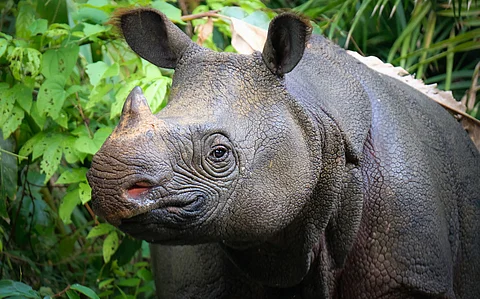

A new study has suggested a taxonomic revision of the critically endangered Javan Rhino (Rhinoceros sondaicus). It should be placed in a new genus, according to the authors as its dentition and morphology suggest a different evolutionary path.
The Javan and the Indian rhinoceros (Rhinoceros unicornis) are two of five extant rhinoceros in Africa and Asia. The others are the White rhino (Ceratotherium simum), the black rhino (Diceros bicornis) and the Sumatran rhinoceros (Dicerorhinus sumatrensis). These three have two horns, while the Javan and the Indian have one horn.
Zoologist Francesco Nardelli and paleontologist Kurt Heißig compared the Javan rhino with the Indian rhino, studying their fossils, ecological and morphological adaptations.
“The fossils, the ecological and morphological adaptations of both species, suggest designating 'Rhinoceros' sondaicus as distinct from Rhinoceros unicornis, under the one-horned rhinoceros Eurhinoceros, as proposed by Gray (1868). Eurhinoceros sondaicus emerges as a persistently more primitive form,” the researchers wrote. British zoologist John Edward Gray had first described the Javan rhino in 1868.
According to both researchers, the Javan and the Indian followed separate evolutionary paths not due to geographical isolation but rather as a result of ‘niche partitioning’.
Both rhinos developed their own ‘ecological niches’. This not only prevented direct competition but also contributed to their distinct evolutionary trajectories.
The Javan rhino became a ‘browser’, primarily consuming leaves, twigs, and other parts of woody plants. The Indian rhino, on the other hand, became a ‘grazer’, mostly eating grasses and other low-growing vegetation.
This led to differences in skull shape and dentition.
So, while the Javan rhino has a slender skull, a broader and lower back of the head, and a shorter nose and teeth suited for browsing leaves, the Indian rhino has a more robust skull, and taller teeth adapted for grazing on grasses.
“Since the extant African rhinoceroses are classified into different genera, it is reasonable to separate Rhinoceros and Eurhinoceros due to their similar dietary adaptations, among a number of other characteristics,” wrote Nardelli and Heißig.
“In our view, the phenotypic and adaptive differences observed between the two lineages warrant a reassessment of its taxonomic status at the genus level. This approach not only reflects their evolutionary separation but also provides a clearer framework for better understanding of their distinct characteristics within a phylogenetic context,” they added.
A taxonomic review of the genus Rhinoceros with emphasis on the distinction of Eurhinoceros (Perissodactyla, Rhinocerotidae) has been published in the journal ZooKeys.